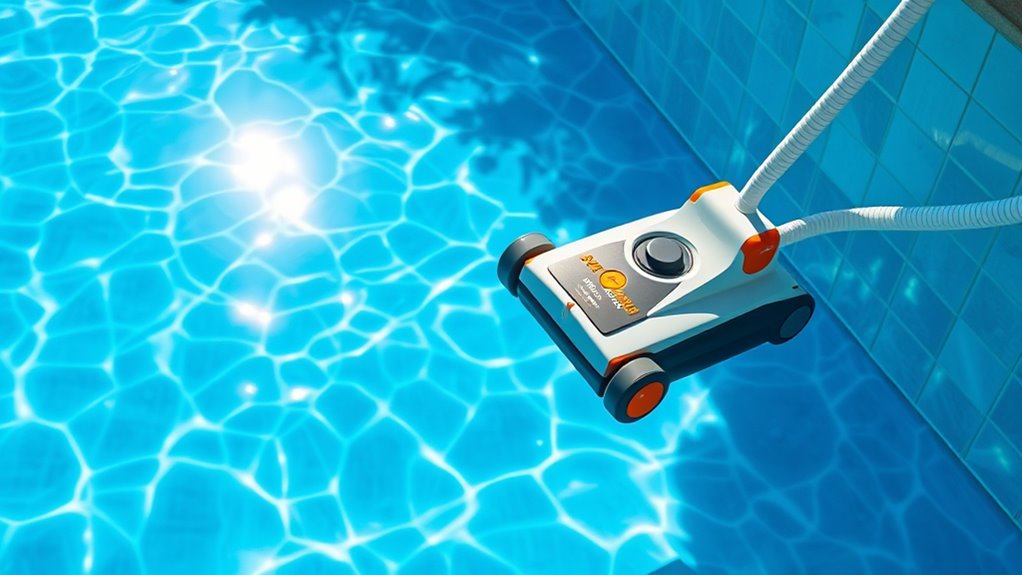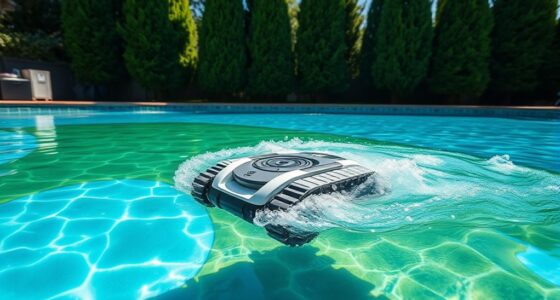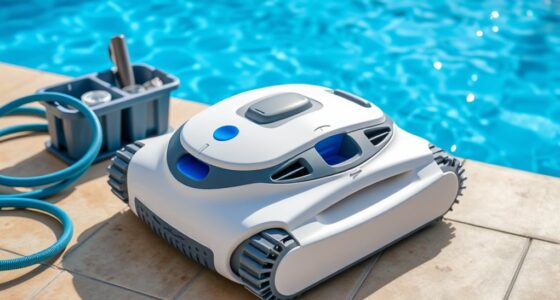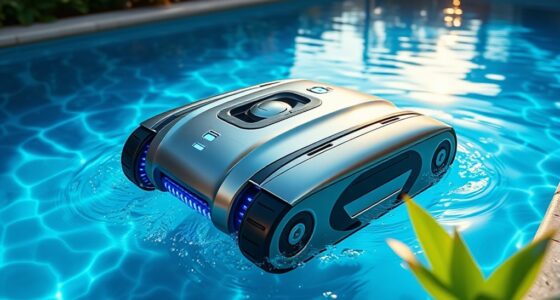You should run your suction pool cleaner at least once a week to keep debris in check and maintain water clarity. During heavy use, storms, or high debris days, increase the frequency to daily or every few days. Regularly monitor your pool’s condition, debris buildup, and water chemistry to adjust cleaning schedules as needed. Staying on top of these signs helps keep your pool clean and your equipment working efficiently—learn more to optimize your routine.
Key Takeaways
- Run your suction cleaner at least once a week for routine debris removal and to maintain water clarity.
- Increase cleaning frequency during heavy use, storms, or when debris accumulation is noticeable.
- Adjust cleaning schedule seasonally; more frequent cleaning in warmer months with higher algae growth.
- Monitor water clarity and debris levels regularly to determine if more frequent cleanings are necessary.
- Ensure the cleaner’s filter and suction are functioning properly to maintain efficiency and extend equipment lifespan.
Factors Influencing Cleaning Frequency
Several factors can influence how often you should run your pool cleaner, and understanding these will help you maintain a clean and healthy pool. One key factor is the chemical balance, as proper pH and sanitizer levels reduce debris buildup and algae growth, lessening the cleaning needed. Additionally, equipment maintenance plays a pivotal role; well-maintained filters and pumps ensure your cleaner operates efficiently and consistently. If your pool experiences heavy use, frequent storms, or high debris, you’ll need to run your cleaner more often. Conversely, in stable conditions with balanced chemicals, less frequent cleaning may suffice. Monitoring these aspects helps you determine the ideal cleaning schedule, preventing issues and prolonging your pool equipment’s lifespan. Proper attention to chemical balance and maintenance ensures your pool stays pristine with less effort. Regularly checking your pool’s filter efficiency can also help you identify when more frequent cleaning is necessary. Ensuring optimal circulation can also reduce the buildup of debris, decreasing the frequency of cleaning required. Maintaining proper water chemistry can further reduce the workload on your cleaner by minimizing the formation of algae and biofilms on surfaces. Incorporating regular maintenance routines can help you stay ahead of potential issues and keep your pool in top condition. Furthermore, understanding the effects of debris accumulation can guide you in adjusting cleaning routines for optimal pool health.
Daily vs. Weekly Cleaning: What’s Best?
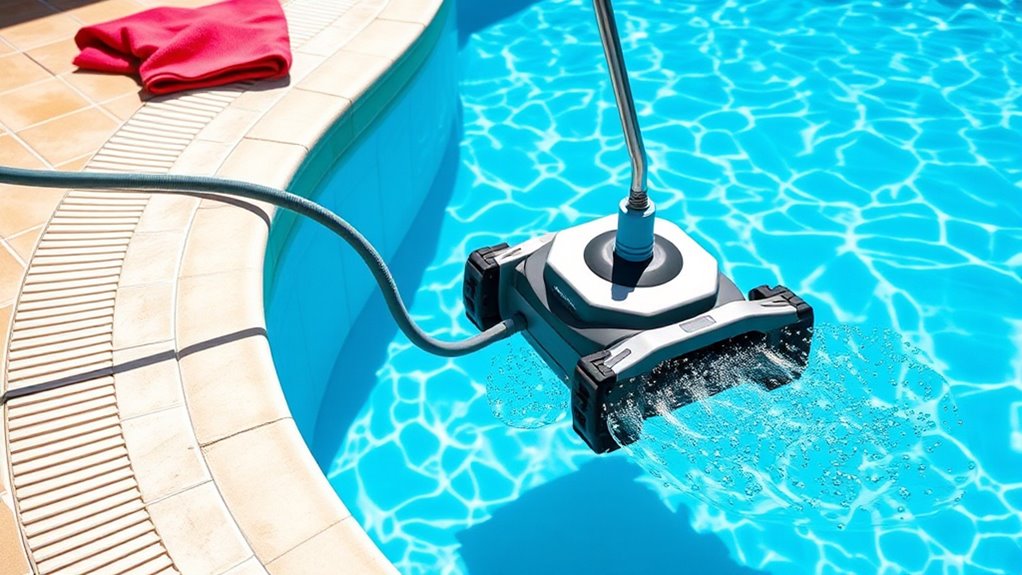
Deciding between daily and weekly cleaning depends on your pool’s usage, environment, and equipment. If you swim daily or have lots of debris, running a robot vacuum every day keeps your water sparkling. For lighter use, weekly cleaning may suffice, with manual cleaning helping in between. Consider this table:
| Frequency | Pros | Cons |
|---|---|---|
| Daily Cleaning | Keeps debris minimal, reduces algae risk | More energy, wear on equipment |
| Weekly Cleaning | Saves time, less wear on cleaner, still effective | Possible buildup, more manual cleaning needed |
For heavily used pools, daily cleaning is ideal. Otherwise, weekly cleaning with occasional manual cleaning will do. Regular maintenance can extend your equipment’s lifespan, and proper tuning can further optimize performance and longevity, ensuring the cleaner operates efficiently over time. Additionally, choosing the right tuning for your pool equipment can optimize performance and longevity. When selecting a suction pool cleaner, consider factors like filter capacity and energy efficiency to ensure optimal operation. Maintaining a consistent cleaning schedule can also prevent clogging of filters, which can hinder performance and increase energy consumption.
Monitoring Pool Condition and Debris Levels
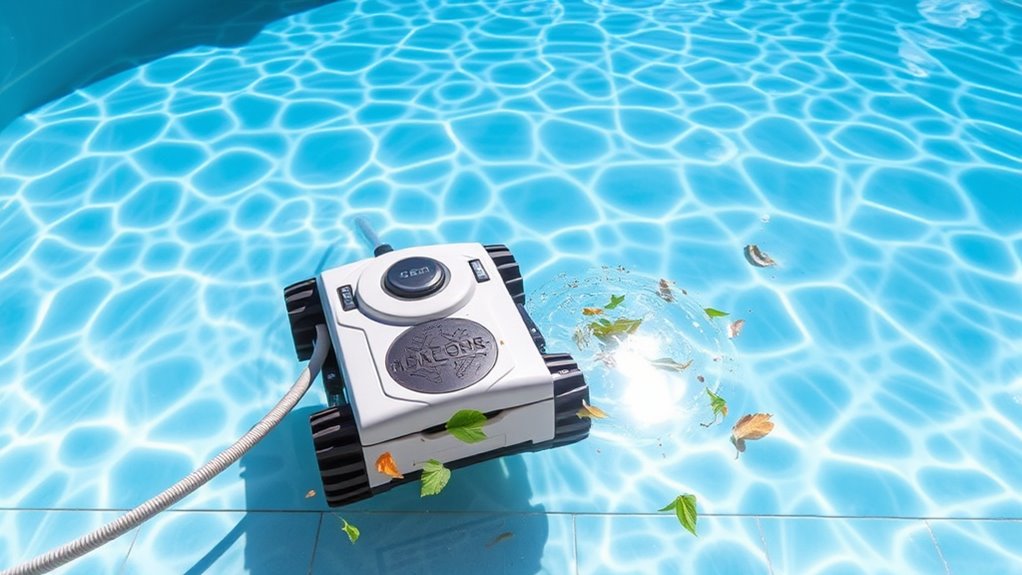
Keep an eye on your pool for signs of debris buildup, like leaves or dirt floating on the surface. Check water clarity regularly to spot murkiness or cloudiness that indicates the need for cleaning. Also, watch for algae or stains on the walls and floor to determine if more frequent maintenance is necessary. Incorporating data-driven strategies can help you establish a routine that keeps your pool in optimal condition. Regularly inspecting your filtration system ensures it functions properly and enhances overall cleanliness. Additionally, monitoring your pool chemistry helps maintain proper pH and sanitizer levels, preventing algae growth and ensuring a healthier swimming environment. Understanding the effect of debris on water quality can further guide your maintenance schedule. To optimize maintenance schedules, consider senior-friendly digital literacy programs that can assist in tracking these parameters more effectively.
Debris Accumulation Indicators
Monitoring your pool’s condition is essential to determine when your cleaner needs to run. Keep an eye on debris accumulation, such as leaves, dirt, and insects floating on the surface or settling on the pool floor. If you notice increased debris, it’s a clear sign your cleaner should operate more frequently. Regular pool filter maintenance helps prevent debris buildup in the system, ensuring ideal performance. Proper chemical balancing reduces algae and other debris that can clog your cleaner or cause staining. Proper water quality management is also crucial for optimizing the efficiency and lifespan of your pool equipment. Maintaining a consistent cleaning schedule can help prevent debris buildup before it becomes a problem. Additionally, understanding debris levels and how they fluctuate throughout the season can help you tailor your cleaning routine more effectively. Monitoring debris accumulation trends allows you to anticipate when extra cleaning sessions might be necessary, especially during seasons with higher plant or insect activity. By staying vigilant about debris levels and maintaining your pool’s chemical balance, you can prevent overworking your cleaner and keep your pool sparkling. Incorporating regular maintenance routines can further enhance the overall health of your pool and its cleaning systems.
Water Clarity Assessment
Evaluating water clarity is a quick and effective way to gauge your pool’s cleanliness and determine if your cleaner needs to run more often. Clear water indicates proper pool chemistry and ideal equipment efficiency, while cloudiness suggests debris or imbalance. Regularly check the water for signs like murkiness, discoloration, or floating debris. If you notice these issues, it’s time to run your suction pool cleaner more frequently. Keep in mind:
- Cloudy or murky water reduces visibility.
- Floating debris signals the need for cleaning.
- Poor water clarity may point to imbalanced chemicals affecting equipment performance.
- Using a keto diet tracking app can help ensure your overall health and energy levels support regular pool maintenance.
- Incorporating air quality features such as filtration and monitoring can help maintain optimal water clarity and reduce debris buildup.
- Ensuring proper filtration system operation is essential for maintaining clear water and reducing the frequency of cleaning.
- Regular maintenance of your pool’s filtration system can help prevent issues that lead to cloudiness and debris accumulation.
- Maintaining proper water chemistry is crucial for preventing algae growth and ensuring your pool stays clean and clear.
Algae and Stain Signs
Algae and stains can quickly indicate your pool isn’t as clean as it should be. If you notice green, black, or brown spots, it signals that your pool chemistry might be off, allowing algae growth or staining. Regularly monitoring these signs helps you determine if your cleaner needs to work more often. Poor debris removal can also contribute to staining and algae buildup. Consider equipment upgrades, like a more powerful suction pool cleaner or improved filtration, to keep debris in check. Maintaining balanced pool chemistry minimizes algae growth and staining, reducing the need for frequent cleaning. Catching these signs early ensures your pool stays inviting and requires less intensive cleaning sessions, saving you time and effort in the long run. Additionally, floating on water can sometimes mask debris or algae, making regular inspections even more crucial.
Adjusting Your Routine for Weather and Season Changes
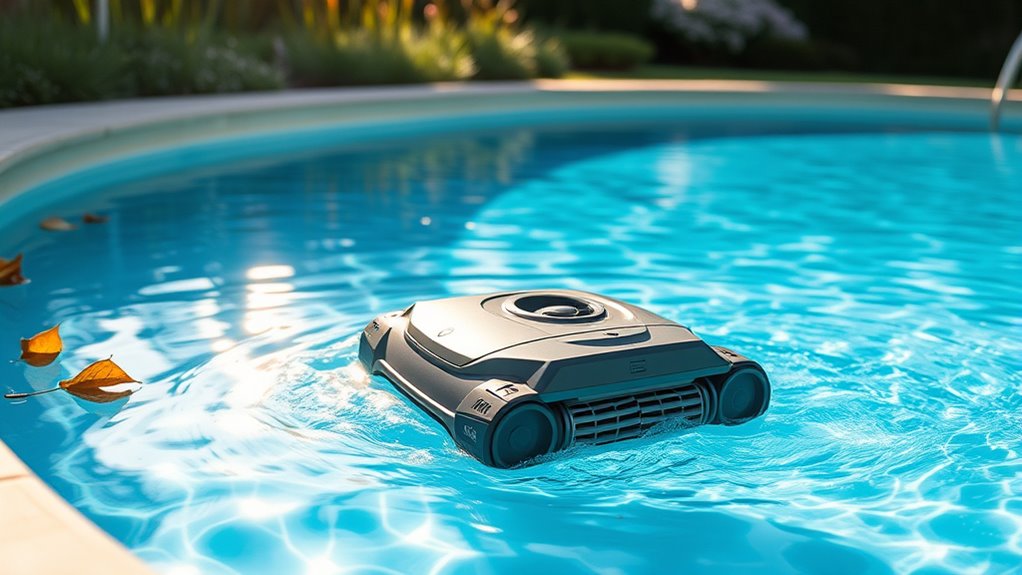
As the seasons change, your pool cleaner routine should adapt to guarantee ideal performance and cleanliness. Cooler months may reduce debris, so you can lessen cleaning frequency, but you should still monitor the pool filter and chemical balance regularly. During heavy rain or wind, increased debris can clog your pool filter faster, requiring more frequent cleaning cycles. In warmer months, algae growth accelerates, so maintaining proper chemical balance is essential to prevent buildup. Adjust your schedule by:
Adjust your pool cleaning routine seasonally for optimal performance and clarity.
- Increasing cleaning frequency after storms or heavy use
- Monitoring chemical levels weekly to prevent algae and cloudiness
- Ensuring your pool filter is clean and functioning efficiently
Tips for Efficient and Effective Pool Cleaning
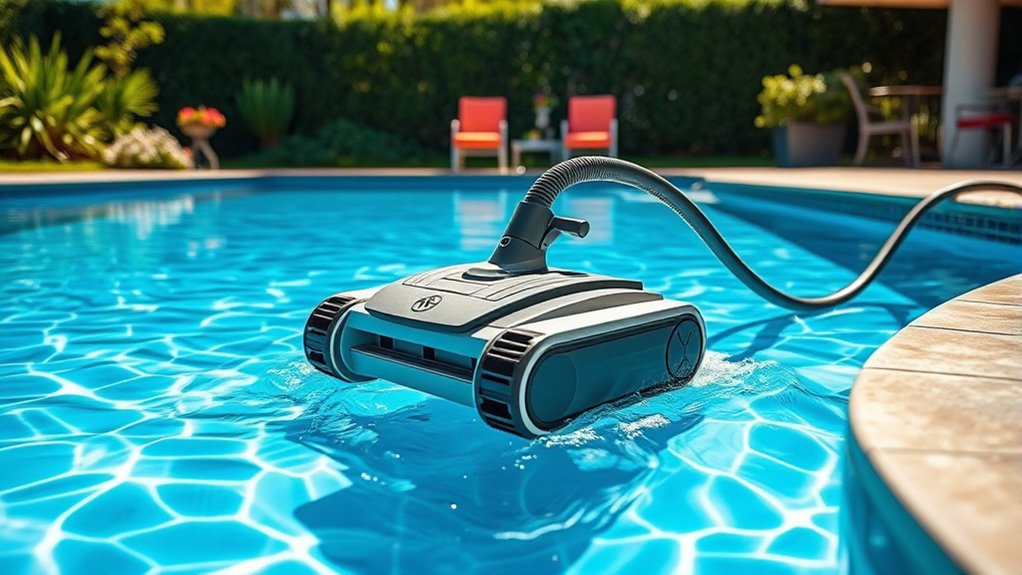
To keep your pool clean and well-maintained, establishing an ideal cleaning schedule is key. Regular maintenance not only improves cleaning efficiency but also extends the lifespan of your equipment. Follow these tips to guarantee your pool stays sparkling and functions smoothly year-round.
Optimal Cleaning Schedule
Establishing an ideal cleaning schedule is essential to keep your pool sparkling and functioning efficiently. Regular cleaning prevents debris buildup and minimizes pool maintenance issues. To maximize efficiency, consider running your pool cleaner more frequently during peak usage or after storms. A consistent schedule helps catch problems early and reduces the need for cleaner troubleshooting later.
Keep these tips in mind:
- Run your cleaner at least once a week for general maintenance
- Increase frequency during heavy use or after storms
- Monitor cleaner performance regularly to identify issues early
Maintenance for Longevity
Maintaining your pool cleaner properly guarantees it stays effective and lasts longer. Regular cleaner maintenance ensures robotic efficiency remains high, preventing clogs and mechanical issues. Check and clean brushes, filters, and suction ports after each use to remove debris and buildup. Inspect hoses and connections for leaks or wear, replacing parts as needed. Keeping the cleaner in good condition minimizes strain on its motor, reducing the risk of breakdowns. Proper maintenance also improves cleaning performance, saving you time and energy. Store your cleaner in a dry, shaded place when not in use to prevent damage from sun exposure. Consistent upkeep is key to maximizing longevity and ensuring your pool stays spotless with minimal hassle.
Signs That Indicate More Frequent Cleaning Is Needed
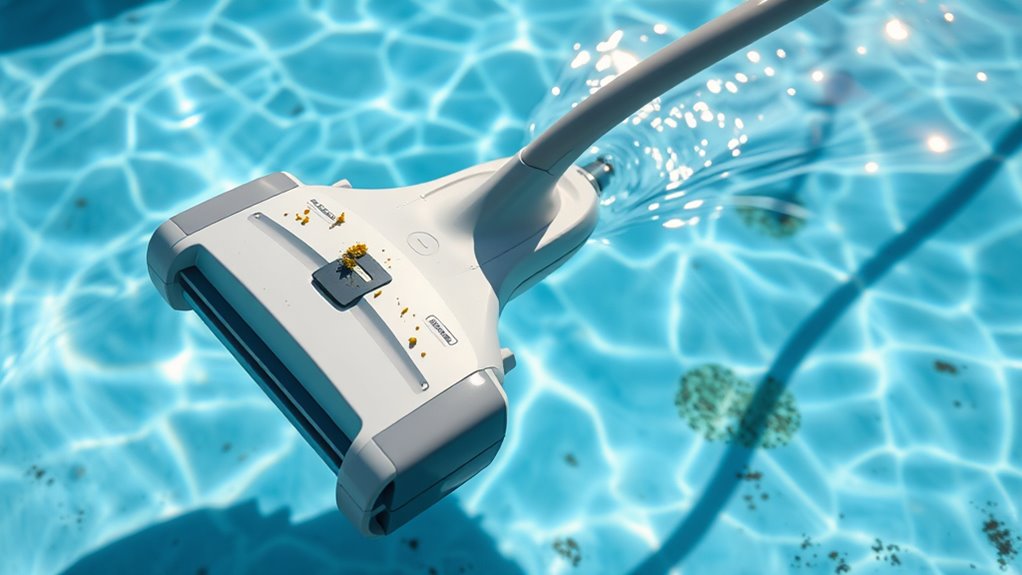
If your pool cleaner is working overtime or you notice debris accumulating faster than usual, it’s a clear sign that more frequent cleaning might be necessary. Keep an eye on these indicators:
- Increased debris in the skimmer basket or on the pool floor
- Uneven or slow-moving suction from your cleaner
- Pool water showing signs of poor chemical balance, like cloudy water or algae growth
Regular pool equipment inspection can help identify issues early, preventing dirt buildup. When debris accumulates quickly, it often signals that the pool needs more frequent cleaning to maintain proper chemical balance and overall health. Addressing these signs promptly ensures your cleaner operates efficiently and keeps your pool sparkling.
Frequently Asked Questions
Can I Over-Clean My Pool With a Suction Cleaner?
You might wonder if over-cleaning your pool with a suction cleaner is possible. While running it too often can disturb your pool chemistry and lead to equipment maintenance issues, most pools don’t require daily cleaning. Regularly check and adjust your chemical levels, and only run your suction cleaner as needed—usually a couple of times a week. This approach keeps your pool clean without risking over-cleaning or damaging your equipment.
How Does Algae Affect Cleaning Frequency Recommendations?
Algae growth can turn your pool into a swamp overnight, making frequent cleaning essential. When algae proliferates, you’ll need to run your suction pool cleaner more often to combat the rapid spread and keep your water clear. Regular pool maintenance becomes even more critical, as algae can clog filters and damage equipment. To prevent an algae invasion, increase cleaning frequency during warm, sunny months and after heavy rain or storms.
Is There a Difference Between Robotic and Suction Pool Cleaners?
You notice a difference between robotic and suction pool cleaners. Robotic cleaners excel in robotic efficiency, offering thorough cleaning with minimal effort from you. Suction pool cleaners rely on suction power, connecting to your skimmer or pump, and are usually easier to maintain. Robotic cleaners tend to be more advanced and effective on various surfaces, while suction models are typically more affordable and straightforward. Choose based on your pool size and cleaning needs.
What’S the Best Time of Day to Run My Pool Cleaner?
Running your pool cleaner at the right time is as vital as maintaining your pool’s glow! Aim for early mornings or late evenings when pool chemistry is stable, and filter maintenance is easier. This prevents debris from settling and keeps your pool sparkling like a diamond. Avoid midday when the sun’s heat can create evaporation and algae growth, compromising your pool’s pristine condition. Your perfect swim oasis depends on it!
How Long Should Each Cleaning Session Last for Optimal Results?
For ideal pool maintenance, you should aim for cleaning sessions lasting about 1-2 hours, depending on your pool’s size and debris level. A consistent cleaning schedule helps prevent algae buildup and keeps your pool sparkling. If your pool gets heavy use or leaves fall frequently, consider running the cleaner longer or more often. Adjust the duration based on your pool’s needs to maintain clarity and cleanliness efficiently.
Conclusion
Ultimately, your pool’s cleanliness depends on your vigilance, your observation, and your adjustments. By monitoring debris, evaluating water clarity, and responding to changing weather, you guarantee your pool stays inviting, your cleaner runs efficiently, and your swimming experience remains enjoyable. Stay attentive, stay adaptable, and stay consistent—because a well-maintained pool is a reflection of your care, a source of refreshment, and a space of relaxation. Keep these practices in mind, and your pool will reward you season after season.
